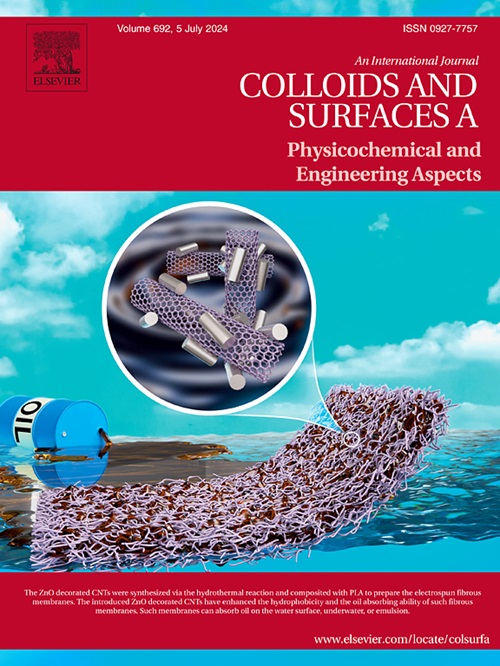Formation of diphenylethylenediamine/sodium dodecyl sulfate/Na2CO3 aqueous two-phase system and its response and selectivity towards aromatic amino acids
IF 5.4
2区 化学
Q2 CHEMISTRY, PHYSICAL
Colloids and Surfaces A: Physicochemical and Engineering Aspects
Pub Date : 2025-08-05
DOI:10.1016/j.colsurfa.2025.137932
引用次数: 0
Abstract
Developing a simple and effective method for detecting and separating amino acids has practical significance. Aqueous two-phase system (ATPS) has the advantages of mild preparation conditions, good stability, and high biocompatibility. In this study, an ATPS exhibiting distinct responses and selectivity profiles toward Phe, Trp, and Tyr was constructed using (1S, 2S)-(-)-1,2-diphenylethylenediamine (DPED), sodium dodecyl sulfate (SDS), and sodium carbonate (Na2CO3). It is found that the amino acids can trigger the transformation of the DPED/SDS/Na2CO3 ATPS into a single-phase system, but the critical concentrations required for this phase transition vary significantly among the amino acids: Phe and Trp induce the transition at very low concentrations, whereas Tyr requires a much higher concentration (8–13 times greater than Phe and Trp under optimal conditions). This stark contrast enables the DPED/SDS/Na2CO3 ATPS to serve as a sensitive and visually distinguishable platform for differentiating Tyr from Phe and Trp. Moreover, the DPED/SDS/Na2CO3 ATPS exhibits selective phase partitioning: Phe and Trp preferentially concentrate in the top phase, while Tyr predominantly distributes into the bottom phase. This distinct partitioning behavior allows for the efficient separation of Phe and Trp from Tyr, highlighting the system’s dual functionality for both detection and purification of Tyr from Phe and Trp. These findings indicate the potential of using this system to develop methods for separating and detecting the amino acids.
二苯乙二胺/十二烷基硫酸钠/Na2CO3双水相体系的形成及其对芳香族氨基酸的反应和选择性
开发一种简单有效的氨基酸检测分离方法具有重要的现实意义。双水相体系具有制备条件温和、稳定性好、生物相容性高等优点。在这项研究中,用(1S, 2S)-(-)-1,2-二苯乙二胺(DPED)、十二烷基硫酸钠(SDS)和碳酸钠(Na2CO3)构建了一个对苯丙氨酸、色氨酸和酪氨酸具有不同反应和选择性的atp。研究发现,氨基酸可以触发DPED/SDS/Na2CO3 ATPS转化为单相体系,但这种相变所需的临界浓度在氨基酸之间存在显著差异:Phe和Trp在很低的浓度下就能诱导转变,而Tyr所需的浓度要高得多(在最佳条件下比Phe和Trp高8-13倍)。这种鲜明的对比使得DPED/SDS/Na2CO3 atp可以作为区分Tyr与Phe和Trp的敏感和视觉可区分的平台。此外,DPED/SDS/Na2CO3 ATPS表现出选择性相分配:Phe和Trp优先集中于顶相,Tyr主要分布于底相。这种独特的分离行为允许从Tyr中有效地分离Phe和Trp,突出了系统在从Phe和Trp中检测和纯化Tyr的双重功能。这些发现表明了利用该系统开发分离和检测氨基酸方法的潜力。
本文章由计算机程序翻译,如有差异,请以英文原文为准。
求助全文
约1分钟内获得全文
求助全文
来源期刊
CiteScore
8.70
自引率
9.60%
发文量
2421
审稿时长
56 days
期刊介绍:
Colloids and Surfaces A: Physicochemical and Engineering Aspects is an international journal devoted to the science underlying applications of colloids and interfacial phenomena.
The journal aims at publishing high quality research papers featuring new materials or new insights into the role of colloid and interface science in (for example) food, energy, minerals processing, pharmaceuticals or the environment.

 求助内容:
求助内容: 应助结果提醒方式:
应助结果提醒方式:


